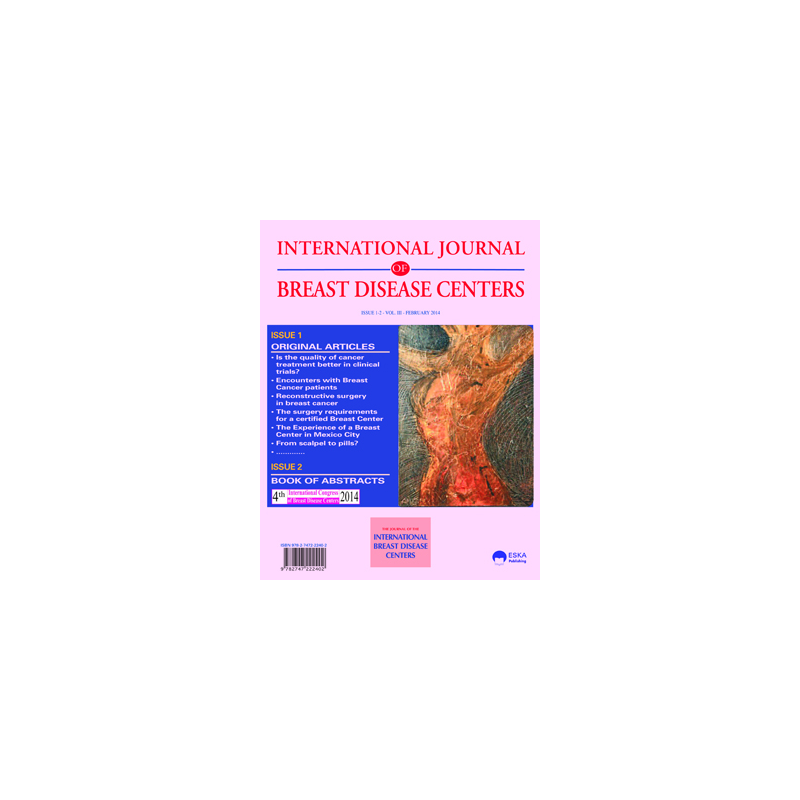



 Security policy
Security policy
(edit with the Customer Reassurance module)
 Delivery policy
Delivery policy
(edit with the Customer Reassurance module)
The surgery requirements for a certified Breast Center
Maurício Magalhaes Costa (Brazil)
Abstract
Stage I, II, IIIA, and operable IIIC breast cancer often requires a multimodality approach to treatment. Diagnostic biopsy and surgical procedure that will be used as primary treatment should be performed as two separate procedures. In many cases, the diagnosis of breast carcinoma using core needle biopsy or fine-needle aspiration cytology may be sufficient to confirm malignancy. After the presence of a malignancy is confirmed and histology is determined, treatment options should be discussed with the patient before a therapeutic procedure is selected. Options for surgical management of the primary tumor include breast-conserving surgery plus radiation therapy, mastectomy plus reconstruction, and mastectomy alone. Surgical staging of the axilla should also be performed. Survival is equivalent with any of these options as documented in randomized prospective trials (including the European Organization for Research and Treatment of Cancer’s trial [EORTC-10801]). Selection of a local therapeutic approach depends on the location and size of the lesion, analysis of the mammogram, breast size, and the patient’s attitude toward preserving the breast. The presence of multifocal disease in the breast or a history of collagen vascular disease are relative contraindications to breast-conserving therapy. The axillary lymph nodes should be staged to aid in determining prognosis and therapy. Sentinel lymph node (SLN) biopsy is the initial standard axillary staging procedure performed in women with invasive breast cancer. The SLN is defined as any node that receives drainage directly from the primary tumor, therefore, allowing for more than one SLN, which is often the case. Studies have shown that the injection of technetium-labeled sulfur colloid, vital blue dye, or both around the tumor or biopsy cavity, or in the subareolar area, and subsequent drainage of these compounds to the axilla results in the identification of the SLN in 92% to 98% of patients. These reports demonstrate a 97.5% to 100% concordance between SLN biopsy and complete axillary lymph node dissection (ALND).For patients who opt for a total mastectomy, reconstructive surgery may be used at the time of the mastectomy (i.e., immediate reconstruction) or at some subsequent time (i.e., delayed reconstruction). Breast contour can be restored by the submuscular insertion of an artificial implant (saline-filled) or a rectus muscle or other flap. If a saline implant is used, a tissue expander can be inserted beneath the pectoral muscle. Saline is injected into the expander to stretch the tissues for a period of weeks or months until the desired volume is obtained. The tissue expander is then replaced by a permanent implant. (Visit the FDA’s Web site for more information on breast implants.) Rectus muscle flaps require a considerably more complicated and prolonged operative procedure, and blood transfusions may be required. Surgical requirements for a Breast Center are A proportion of at least 50 percent of all patients diagnosed with early stage breast cancer (Stage 0, I, II) are treated with breast conserving surgery, and compliance is evaluated annually. Axillary sentinel lymph node biopsy is considered or performed for patients with early stage breast cancer (Clinical Stage I, II) All appropriate patients undergoing mastectomy are offered a preoperative referral to a reconstructive/plastic surgeon. Reconstructive surgery is provided by or referred to reconstructive/ plastic surgeons that are board certified or in the process of board certification.